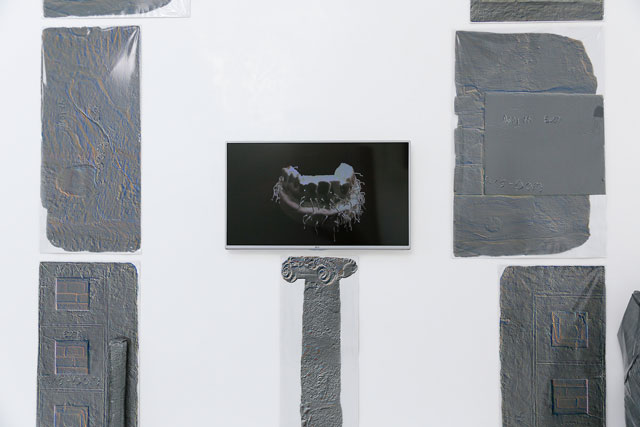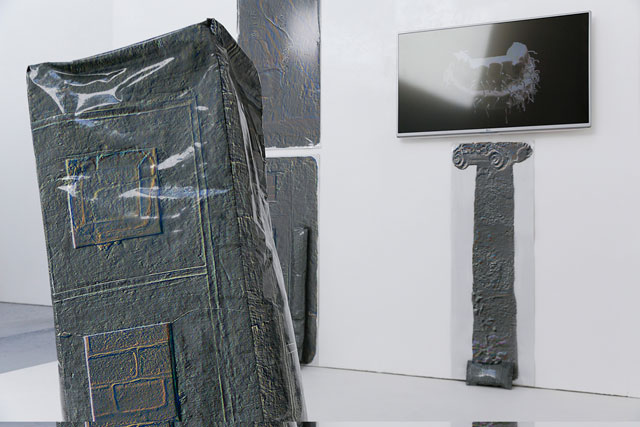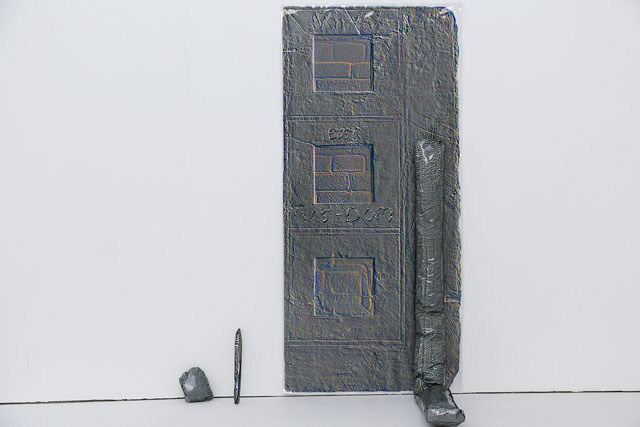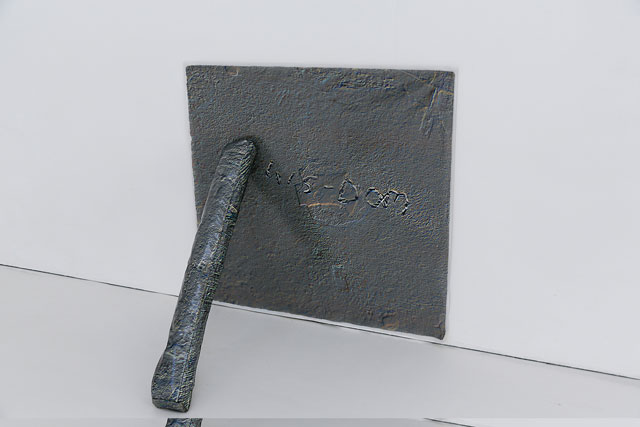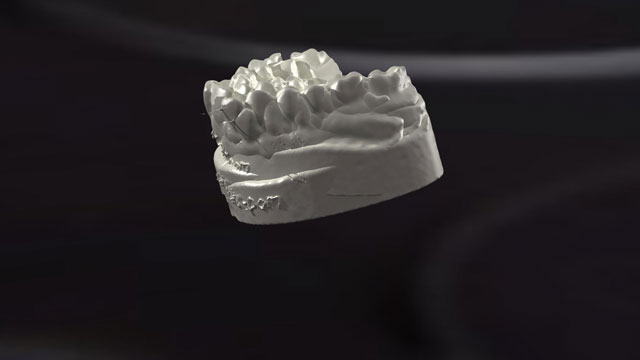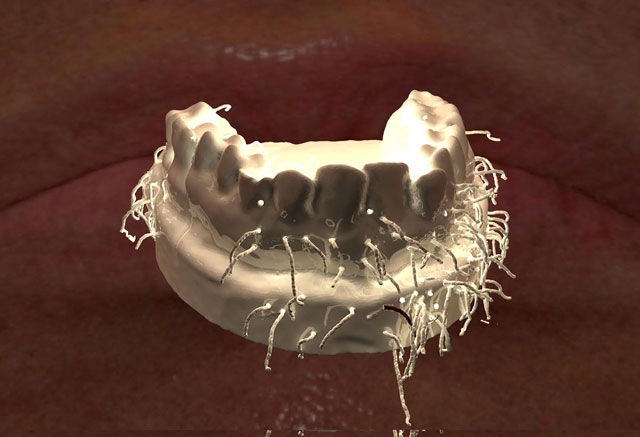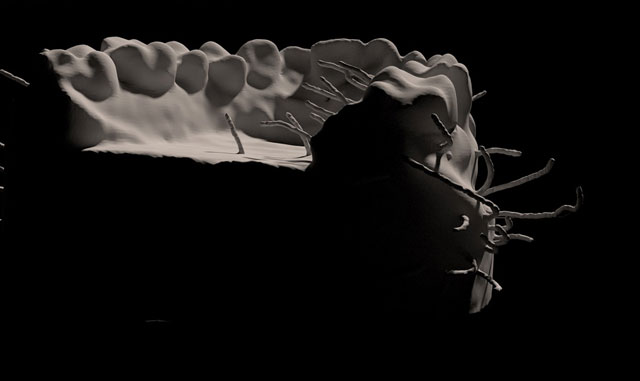

by IZABELLA SCOTT
Scottish artist and printmaker Susannah Stark (b1988) is a cultural omnivore, chewing over ancient and contemporary technologies alike: from encrypted stones of ancient Romania and relics of the Museum of Icelandic Sorcery and Witchcraft to the voices of Scottish telesales, virtual shamans and spam emails. Her work is a process of remembering and, at the same time, a consideration of stored cultural memory, as she muses on the preservative environments of swamps and bogs, hard-drives and digital memory technologies. Stark suggests these “technologies” are linked by the practice of Spolia, an architectural term for the repurposing of old material in new construction – where stones and images, words and ideas are masticated, digested and expelled the other side of a collective cultural colon.
Stark’s sound and video installation North East Wis-Dom (2016), comprising digitally printed stones and Inside Out, a video about wisdom teeth set to a reggae backtrack, won the 2016 Augustus Martin Print Prize at the Royal College of Art; a new incarnation of the piece is on display at the CAFA Art Museum in Beijing and the work will be shown at the International Print Center New York in early 2017. A newly commissioned surround-sound work was shown as part of the film program at Art Basel Miami 2016 and Stark is developing surround-sound installations that uncover shared histories and engage collective memory, made in Jamaica and Miami.
I met Stark on several occasions to talk about Spolia, swamps and Icelandic necropants. In the run up to her show in Miami, we exchanged long and sprawling emails that emulsified a potent mixture of sources and ideas, from cultural theory, ancient history and life in late capitalism. This interview is a fragment of that discussion – a relic, so to speak, from the bog.
Izabella Scott: Your installation North East Wis-Dom (2016) featured a set of digitally printed rocks and a video with a rotating jaw. Were you attempting an archaeology of knowledge of some sort?
Susannah Stark: A lot of recent work stems from the gradual realisation that I come from a Presbyterian iconoclastic culture that typically heralds the ruins of ancient cultures as fetish objects. You can see evidence of this in Edinburgh, which is sometimes dubbed the Athens of the North, and where there are many buildings that look like Greek or Roman temples, such as the Acropolis and the Royal Scottish Academy building, which is a conglomerate of popular historical styles. Then there is Glasgow, with its architecture and culture shaped by the industries, including its involvement with slavery – with street names including Tobago Street, Jamaica Street and Nelson Mandela Place.
This was the starting point for my MA show, North East Wis-Dom, and continues to inform the work I am making now; memories of places I have lived in, or travelled to, bleed into each other, mixing with early musical influences that create a map of relation. I grew up in Fife, which feels like it’s a kind of middle ground; it was never a Gaelic-speaking region and the inhabitants were often thought of as part of England, and I believe this has contributed to my feeling of being a bit of an outsider both to Scottish and British culture as a whole. I travelled to Greece when I was 21 and encountered the ruins of Athenian temples sectioned off as tourist attractions, preserved among sprawling concrete suburbs. I later travelled around Romania to discover more ruins (my granddad was born in Bucharest), always following these kinds of familial or broader cultural ties, which I have come to see as part of the common process of filiation. Every time I have returned to the UK, I have seen it differently, which has caused me to ask questions about what an empire is and what it can do, and, ultimately, what is its legacy? North East Wis-Dom is an installation work that was formed through thinking broadly about what my origin is, what we are, how we can understand that better. “The North” is a place where history and mythology, reality and fiction collide, and this in turn becomes a selective history that is taught in schools, fed back to us through the narrative of legitimisation – via popular media and culture.
I became interested by the way the physical presence of citizens both real and fictional have their names identified by the cities they inhabited. This is part of the process of legitimacy, the inherited “Wis-Dom” from those who have come before. The feeling of walking through “James Joyce’s Dublin” or “Robert Louis Stevenson’s Edinburgh” as a widening of viewpoints, a sharing with others in a work of literature in one sense, but also a selective widening, that is predicated on exporting one’s cultural dominance over another. I listen to a lot of reggae and, especially since living in London, I have started to feel the way the residual energy of voices and musical styles has shaped, and continues to shape, areas such as Brixton. It is present, too, in cities such as Glasgow, where cultural movements emerged through the voices of working people. We are never doing something alone; we are adding voices to the chorus that has come before.
Making this exhibition was about working backwards, in a sense: being in the present moment where everything is happening at once as a chaos of voices on the internet, it feels urgent to listen to the voices of the past to try and open this out; creating a space for slowing down and listening.
IS: Was the voice a kind of currency at the centre of your thinking?
SS: I’m interested in how accents from around the UK seem to carry different frequencies of power and trust and, how, for example, certain voices which are now commonly heard in the public domain, from machines and announcements, may delineate our sense of public and private space. Scottish people have often been employed by telesales companies for their trustworthy accents, according to a careers article on the Wall Street & Technology website, which quotes the chairman of a UK-based company, who says: “Within Anglo-Saxon culture, Scottish accents are imbued with a certain brand value for things like probity and financial caution” and that, on hearing a Scottish voice, “people are more inclined to feel their inquiry is being dealt with sensibly and responsibly – people trust that sort of accent.”
This brand of chaste and conservative “Scottishness” seemed to me at odds with the reality of people’s attitudes, people who were and are still finding their voice amid recent political events.
As a guest curator for Her Noise Archive in 2012, the philosopher Nina Power spoke of “the soft and pleasant voice heard on public transport, and increasingly in public spaces, [that is] co-opted into manipulating a public into staying alert and vigilant while in transit”. To my mind, this arises from a technology-driven society that is intent on quick decision-making for short-term gain and function; use of the machine-made and often female voice to control a populous. It has worrying implications – a disappearance of the expressive voice, the voice of the people, from public spaces.
I believe there is a seed of consciousness in what the “technologised” female voice or “telephonised” northern accent obscures as it tries to reassure a supposedly permanently anxious public, that can help us to understand how the voice gains currency for its ability to transform and shape our realities; this was influential in my using my own voice within the installation.
The vocal element of North East Wis-Dom was a curious mismatch of my soft feminine Scottish voice with the reality of capitalist extravagance; unveiling unconscious side-effects in the lyrics. There was a disconcerting rift created between the person speaking and what is being said, a push and pull between hypnotic contemplation and active listening. It’s also about the use of surround sound in the gallery; the potential of the voice to emerge from any of the objects in the installation. The voice is kind of offstage, disembodied. There is something very intimate about being spoken to, but at the same time of possibly being a long way away. For me, voice is a relationship between intimacy and distance.
IS: You read from spam emails, self-help websites and virtual shamans, as if to highlight the constant flow of things being bought, sold and digested by the mouth, or to show the mouth as a “host” that is inhabited by a parasite. There are parallels to ventriloquism and puppetry. Is your mouth, quite literally, a mouthpiece?
SS: I see the mouth as a symbolic orifice, which has the ability to regurgitate and create new forms of cultures. For me, it is a direct expression of what an empire is, what an empire does and the legacy it leaves. In his 2014 book Lexicon of the Mouth, Brandon LaBelle explains how we are linked to the empire through the act of the bite, an act that cuts into the material world and into language in search of transformation. This was influential on my idea of placing the mouth at the centre of my show. The animated mouth is a site of excess; it has had a process or presence inflicted on it. It regurgitates language, which has had a physical manifestation on its appearance; in the video, you can see flopping extrusions, parasites, on the surface of the mouth.
I see the mouth and the voice as forming a strained relationship. The mouth is the physical cavity in which words are formed; its movements are vital productions by which speech is extended and shaped; while at the same time, it is inhabited by language external to it: in this case the computer-generated language of spam and sales gloss which is parasitic and contorts it. As a modulating device, the mouth has a two-way relationship with the world around it. Language goes in and language comes out. In a world of digitised voices, it’s important to have an encounter with the mouth to see what we’re dealing with. I understand the mouth here as a disruptive orifice: it is unavoidable.
I don’t think it’s entirely a mouthpiece for something other because it regurgitates information; it is there to remind the viewer that they are not in a space of reliable symbolism.
IS: The digitally printed rocks take the form of sparkling green cushions and they resemble a distorted souvenir of some great antiquity. Are they sourced from ancient relics?
SS: The soft sculptures represent the facades of stone statue bases from the archaeological site of Istria in Romania. They mark different periods of history of that region, which was once an ancient Greek sea port and was later colonised by the Roman and Byzantine empires. The site is at the shores of the Black Sea in a shifting silt-swampland that preserved a lot of objects from the time when it was permanently occupied by people.
I used the stones from Istria in my show partly because they have text inscribed on their surface, and that intrigued me, that those stones were public documents of their time; operating like the texts, tablets and emails we have today. I later discovered that they were often set up for financial reasons and one of them was a message from the mother of a family of slaves to their former master under Roman rule, a formality to acknowledge their freedom on his death, as was the custom. The idea that slavery has existed since the perceived beginning of our western society, and involving all parts of society, is no new thing, but it still rocked me to a point of wanting to bring it into my installation. People associate slavery mainly with black history and I want to talk about how it is a moral problem that affects us all, ongoing in today’s world. A quote from Édouard Glissant’s Poetics of Relation stuck in my mind while I was making these sculptures: “Navigating the green splendor of the sea […] still brings to mind, coming to light like seaweed, these lowest depths, these deeps, with their punctuation of scarcely corroded balls and chains. In actual fact the abyss is a tautology: the entire ocean, the entire sea gently collapsing in the end into the pleasures of sand, make one vast beginning, but a beginning whose time is marked by these balls and chains gone green.”
This was a way that I came to understand the stones not as ruins, but as part of a continuity of forms and voices that help us to relate to one another, even in a post-digital future.
I have always observed how people navigate historical sites through image-capture as a way to deal with those objects. There is a lot of focus on ownership and power. I noticed that people like to touch things on display, and how touch is often linked to value; the more isolated and prestigious the object, the more valuable it becomes. Touching was reserved for sacred objects, whose power could be absorbed by those in close contact. During my exhibition, I had to physically be in the space to tell people they were welcome to move the printed sculptures; people are used to observing from a distance or through a lens. At one point, a security guard told people off for moving my work! It was important to me to create an environment where the relationship between artwork and viewer was open.
IS: You tease out a relation between swamps and archives, where the swamp is a kind of immense cultural larder. There is historical precedent for this, and sacred things have been preserved in swamps and bogs: the famous example is a book of psalms that was burped out of a peat bog in Ireland in 2006. Do you see the swamp as storage site – a place of stored wisdom?
SS: The consciousness of a swamp or peat bog, or the swamp as a kind of giant storage device, is an abstract idea that informs my work on the voice and the mouth-orifice. The swamp or bog converts organic material into energy, which gets pushed further down into the earth, into an immaterial realm of churning matter, a mnemonic abyss. I began to think of this as the process of digestion carried out by the human body; the horror of mastication and dematerialisation of food and recognisable substances as they are broken down in the mouth; the creation of new forms of cultures and languages.
The swamp or bog is, to me, like a giant mouth-orifice that can preserve objects, but also corrupt their content, radically altering their structure as in oral culture. Items are lost and can resurface years later, regurgitated texts like the example you mention. I think of the peat bog or swamp as capable of uprooting and displacing language to other surfaces, manifesting it in new contexts.
IS: I enjoy the word Spolia’s (accidental) kinship with “spoiler”, which in media culture is a form of ruination – to give away the plot, to remove the climax, to dilute the charge. Your cushion stones seem to glitter, and their surfaces are almost holographic, and they remind me of gaming architecture, the ruined and pixelated landscape of Second Life. Are immaterial landscapes implied by your choice of material, such as the vinyl on which you embossed the Istria stones?
SS: I think we are in a contemporary condition of relating to objects primarily through digesting images. I have a strong desire to make things in order to grasp them, at a time of perceptual shifting and greater immersion in virtual worlds; a time when the real world feels not “real” enough, or even too drab, compared with the resolution of a screen. I work with computers every day and it has definitely influenced my vision. I’m interested in how to represent the perceptive gap between something from ancient history and something highly saturated and contemporary. I think it’s also a conversation between what museological inquiry and contemporary art can learn from each other. It’s like using visual tricks to catch people out, to disrupt the gaze or make them question where these things come from. I like to work by offsetting lo-fi effects and techniques with new technology in print, creating something that bears the trace of multiple worlds.
I originally trained as a printmaker; I work and think in terms of images and, although this installation takes up space as a sculptural assemblage, I see it as a work of images and sound that are pertaining to objects so there are constant questions of representation and circulation emerging. It’s like images inhabiting the flayed skin of ancient objects that have previously appeared somewhere, on something else. There are questions about immateriality in that sense; the images are physically hollow arthritic structures, but can be vessels for the incorporeal in a kind of spiritual way, which I think is also conjured by the offstage, disembodied voice that speaks to you. For me, this is a necessary way to get beyond something as pure image.
The printed elements are shown both as flat wall-based work and as sculptures, so there is a constant movement between two- and three-dimensions in the gallery space. Visitors could move the printed stone sculptures around and change the installation layout, which was part of the idea to encounter the strange materiality of those objects, the discovery of text fragments on the surface of the “stones”, which are again offset against a voice soundscape combined with moving image elements.
The installation is an attempt to pull out issues of making images through the potential interaction of print and audiovisual components within the installation, rather than simply present the artefacts; the ruins of a process as any kind of totality, that once was or will be.
IS: There is a reggae soundtrack over Inside Out, where the spamming Scottish voice speaks in rhythm, and there is an echo, perhaps, between your video and Camille Henrot’s Grosse Fatigue (2013), a short film about archives, excess and anxiety, and which has a hypnotic hip-hop backtrack.
SS: I’m interested in Henrot’s film as arising from the condition of trying to comprehend or grasp an infinite mass of information that is, in effect, for ever in excess or out of reach. In her film, the disembodied voice is a backbone, the voice of conscience that is a conduit for seeing time and the frenzied attempts to “can” objects from ancient history to modern domestic scenes, which are amassed as pop-ups on a screen, slipping from grasp. At times the flow of images is aggressive and unstoppable; at times perfectly choreographed. I find the voice a kind of anchor in her work, which regurgitates knowledge and carries the weight of the world (“Grosse Fatigue”) in its breath. I have been thinking about the spatial and expressive quality of voices and samples as a mode of slowing down, an audio excavation process.
During Inside Out you can hear a sample of Strange Things by Ronnie Davis, a reggae track that was popular before I was born, with my voice overlaid reading out extracts of spam emails and advice columns in time to the rhythm. As I mentioned earlier, since moving to London I have been listening to a lot of reggae. It was on my periphery as something I had encountered in the past in Glasgow and the music used to provoke a lot of questions in me. I believe it to be a music rooted in errantry – in having a mobile root – a mode of relation that seems to come from knowledge of the abyss.
I remixed the sample to give a spatial, sculptural feel to the music in the space. In the early 1970s, reggae tracks were often remixed using filters and basic effects such as reverb and delay, creating an overall sensation of echo. Called “dub”, this process created a disorienting experience of sound and a metaphoric space for freedom and change. They say that dub was one of the first forms of popular music to turn the idea of song inside out.
The lyrics are quoted from social media channels, online shamans, self-help websites, spam emails and archival TV ads. The aim was to highlight the flow of things – of language – traded in a capitalist marketplace, and exorcise it through spoken word.
I want to take these ideas forward in future work, I’m working on an audiovisual exhibition that interrogates the act of listening to the past, but also the act of listening as something that could aid in the construction of a radical group subjectivity, rather than just displaying aural “artefacts”; displacing subjects. This requires a rethinking of identity; approaching the subject from the perspective of having roots in something that is roaming or based on errantry, and is shaped by voices.
IS: We talked of your process of embossing the Istria stones on vinyl, and I wonder what role 3D imaging plays in all of this? There’s something of an overlap between Spolia appropriation and the 3D digital replication of ancient artefacts, the most famous example being the replica of Tutankhamun’s tomb, made for tourists to visit several years ago.
SS: I think my relationship to 3D imaging is based on thinking about sculpture from a printmaker’s perspective, creating work that oscillates between image and object. The 3D scan can look quite generic without its surface map; 3D imaging takes physical objects back to the world of brittle matter, like a virtual clay. Working in this way was for me a way to talk about what Hito Steyerl describes in her book The Wretched of the Screen as: “Poor images are poor because they are not assigned any value within the class society of images … Their lack of resolution attests to their appropriation and displacement.”
She argues that this condition is not only connected to the neoliberal restructuring of media production, but that it’s related to the postcolonial restructuring of nation states, their cultures, and their archives. Steyerl describes how Spolia and issues of value extend into the realm of image circulation and exchange; how, in a society bent on accelerating to a point of excess, we are left with fragile, brittle image-shells, images with arthritis, their spines uprooted and displaced.
I have been thinking around Spolia, an architectural term used to describe the repurposing of building stone for new construction, or the reuse of decorative sculpture on new monuments, sometimes and more often for financial reasons. When I came across those stones at Istria I learned that they would have had sculptures on top of them, but these had been acquisitioned by museums. When the town of Istria was colonised, the statue bases left behind were used in the building of new walls, repurposed for the successive empire, sometimes even being built directly on top of the ruins of the previous settlement. To me, this relates to the constant ongoing recycling of images that is a part of life in late capitalism.
IS: You’ve been returning to Iceland since 2006 and have made projects at the Association of Icelandic Visual Artists in Reykjavik, and other sites in the north Iceland. What is the draw?
SS: I was learning Icelandic for a time and got interested in the sagas; the works of literature that tell of Iceland’s founding mythology. These are great works of filiation, a legitimacy predicated on direct ancestry to the founding fathers of the nation. I once met a conservator who told me that Icelandic people used to wear shoes made of fish skins if they were poor, and pages of the sagas on their feet if they were from a wealthy family. I came to thinking about books as “skins” of text, which, a bit like the 3D scans, could be uprooted and displaced on to other surfaces.
I visited the Museum of Icelandic Sorcery and Witchcraft in the north-west of Iceland. There are incredible objects on show, such as a pair of necropants, which are part of the Viking tradition of generating wealth and prosperity by flaying and wearing the flesh of your enemy.
IS: Necropants?
SS: Yes, trousers made from a dead man’s flesh. They bear relation to Roman ideas of power, social and bodily hierarchies – the idea of wearing the skin of another, to physically get inside another's skin, to inherit their wealthy characteristics. It's like a collapsed image, existing in the body of another. This brings about a problem of morality for all people: there is a lot of focus on ownership and property in our society.
IS: There is a lexicon of skinning and flaying in your work, as you reappropriate images and objects, where the stones in your show are, in some sense, the skins of other bodies. Is your video work Amo Tibi (The Glue Factory, Glasgow, 2016) on the life of a Glaswegian saint, also about inhabiting the life/skin) of another?
SS: Amo Tibi was based on the popular story of Saint Enoch or Teneu, a patron saint of medieval Glasgow, who is reputed to be buried underneath the St Enoch Centre shopping mall in Glasgow. The work is about being a witness, observing in a kind of voyeuristic way how people respond to narrative and inserting yourself in there. This approach has a certain gendered nature, so I was interested in how that might relate to the story of Saint Enoch.
I was writing a lot of short pieces for the voice at this time, that were intended to be sung to an image and fill a gallery space with voices coming from different speakers, different directions. I was thinking a lot about sound and singing and this idea of the communal, or groups of people, and then the individual gesture or voice layered on top of that. The voices are residual, carried over in the furniture of the church, or the apparatus of the exhibition. We have TVs and we have speakers and we have walls and spaces. And in our bodies, we have throats and tongues and mouths and skins. All the apparatus is just these different spaces and divisions that connect us.


